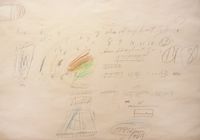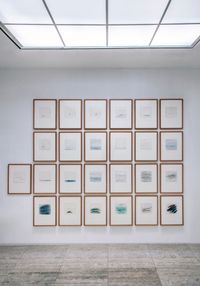Edwin Parker ('Cy') Twombly was a hugely influential American painter, draughtsman, and printmaker known for his fearless approach to blending 'high' and 'low' art through his use of scribbled pencil, crayon, and daubed oil paint.
Read MoreTwombly's scrawls make references to sources from classical mythology and history to the poets and intellectuals Mallarmé, Rilke, Seferis, and Stevens, among others. At the start of his art career, Twombly was a shocking and polarising presence who eventually became an admired art establishment figure. Besides painting, he also made sculptures and photographs.
After he left high school in Lexington, Virginia, Cy Twombly went to the Darlington School for Boys in Rome, Georgia. In 1947, Twombly left to study at the School of Museum of Fine Arts in Boston, where his grandfather lived. From there he returned to Lexington, and then went to New York to study at the Art Students League in 1950. There he became a close friend of the artist Robert Rauschenberg, who encouraged Twombly to enrol at the legendary Black Mountain College in North Carolina, where Twombly attended throughout 1951 and 1952. Twombly was taught by Franz Kline and Robert Motherwell, and influenced by the poet Charles Olson. There, he also met John Cage and Merce Cunningham.
Supported most of his life by the Italian patron, Baron Giorgio Franchetti, Twombly lived in Rome, Italy after moving there in 1957, understandable because of his passion for antiquity. He married Franchetti's sister Tatiana.
Just as Rauschenberg was to revolutionise painting and sculpture with his research into silkscreen printing, photography, found objects, and 3D collage, so Twombly greatly expanded the expressive mark-making possibilities of painting through an almost indecipherable cursive text, hurried doodles, obsessive looping of scratchy lines, and lopsided wiped and flattened islands of casually-applied colour—sometimes on grey or dark-green fields that could be mistaken for blackboards.
Twombly's brilliance lay in his ability to tap into the most primal of emotions using extreme scale, startling colour, poetic association, intuitive compositional nous, frenetic striations and the tactility of raw paint or crayon. His form of dripped and dragged circular calligraphy—and other more 'deranged' wilder collections of marks—was originally deeply disturbing, even for many seasoned cognoscenti in the art world.
The early Cy Twombly paintings are densely packed with feathery pencil marks and intricately layered hovering blotches (examples include School of Athens, 1961; Dutch Interior, 1962: and Untitled, 1964/1984) often on thickly applied gesso. In the 21st century, he introduced brighter, more saturated colour, and more linear paint or crayon and much less pencil (examples include Coronation of Sesostris, 2000; 'Untitled (Bacchus)', 2003–5; Blooming, 2001–2008; and Camino Real V, 2010), allowing more unpainted 'air' into the composition to emphasise modulated shape and a wiry line.
Cy Twombly's notable posthumous solo exhibitions include Sommergäste: Cy Twombly, BASTIAN, London (2021); Cy Twombly: LUX, the Museu d'Art Contemporani d'Eivissa, Ibiza (2016); Cy Twombly: In the Studio, Museum Brandhorst, Munich (2016); Cy Twombly, Centre Pompidou, Paris (2016); Cy Twombly: Painting & Sculpture, Kunstmuseum Basel (2015); Cy Twombly: The Last Paintings and A Survey of Photographs 1954–2011, Gagosian, Los Angeles (2012).
Prestigious posthumous group exhibitions include Hong Kong Exchange, Gagosian, Hong Kong (2021); Epic Abstraction: Pollock to Herrera, Metropolitan Museum of Art, New York (2018); Arcadia, Gagosian, Hong Kong (2017); La Grande Arte dei Guggenheim, Palazzo Strozzi, Florence (2016).
Cy Twombly's artworks (paintings, drawings, and sculptures) are in all the major international contemporary art collections.
John Hurrell | Ocula | 2021





